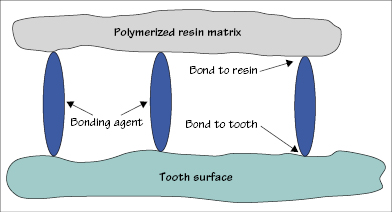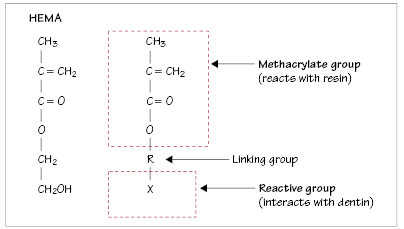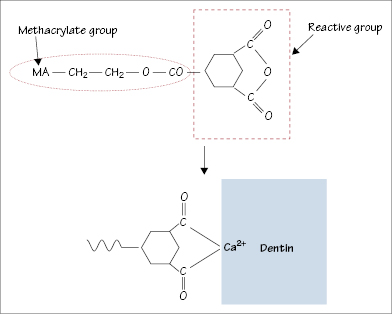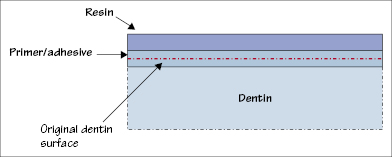33
Bonding to dentin
Figure 33.1 Schematic representation of the coupling action of a dentin-bonding agent providing adhesion between the resin matrix and tooth surface.

Figure 33.2 Bifunctional HEMA molecule: methacrylate group can bond to resin, whereas the active end can react with dentin substrate.

Figure 33.3 Schematic diagram of 4-META and its bond to calcium in hydroxyapatite of conditioned dentin.

Figure 33.4 Schematic diagram of formation of a hybrid layer on dentin.

Box 33.1 Common dentin conditioning agents
10% phosphoric acid
35–37% phosphoric acid
17% ethylene diamine tetraacetic acid (EDTA)
10% maleic acid
10% citric acid + 3% FeCl3
Table 33.1 ;Developments (generations) in dentin-bonding systems
| Development | Characteristics |
|---|---|
| First generation | Bifunctional resin bonded to calcium in hydroxyapatite |
| Second generation | Halophosphorous resin esters bonded to hydroxyapatite |
| Third generation | Partial smear layer removal, hydrophilic monomers, resin adhesive |
| Fourth generation | Three steps (conditioning, priming, and bonding) and three solutions |
| Fifth generation | |
| Single bottle | Separate conditioner; primer and adhesive combined |
| Self-etching primers | Conditioner and primer combined; separate adhesive |
| Sixth generation | Conditioner, primer, and adhesive combined (single solution) |
| Seventh generation | No-mix, self-etching systems |
Table 33.2 Dentin-bonding agents
Stay updated, free dental videos. Join our Telegram channel

VIDEdental - Online dental courses


